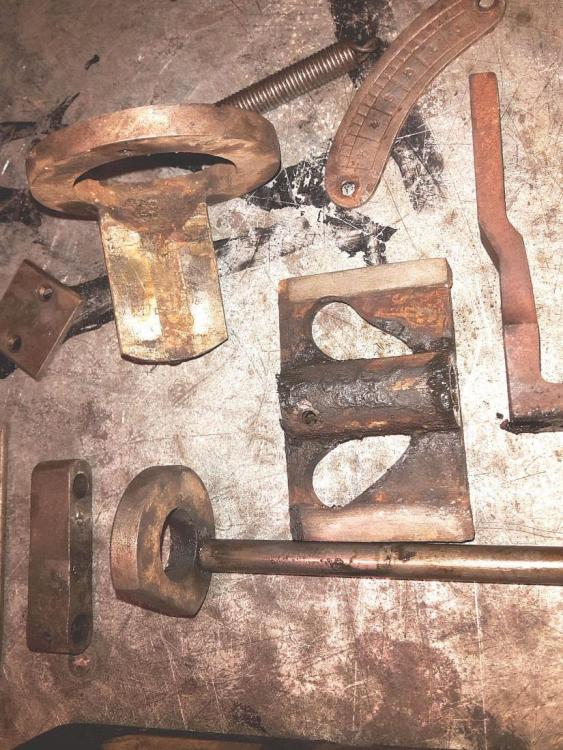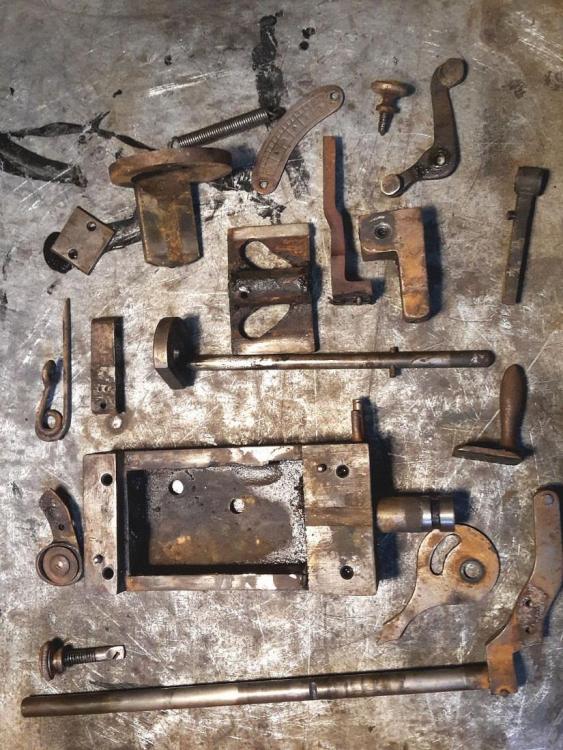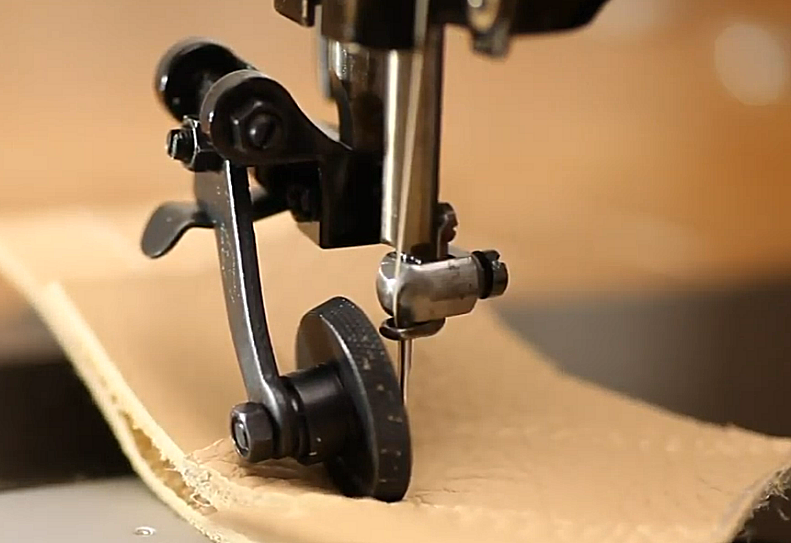-
Posts
5,757 -
Joined
-
Last visited
Content Type
Profiles
Forums
Events
Blogs
Gallery
Everything posted by Constabulary
-

Dürkopp 17 Patcher - Sunday Morning Barn Find
Constabulary replied to Constabulary's topic in Leather Sewing Machines
-
105 is the predecessor of the 205. The subclass 64 on both are drop feed + needle feed - no walking foot
-
Some say they breake the bank at $1K some at $1/2K already and some at $2K or $3K... it depends on how much play money you have (or don´t have) for your hobby. Same with medium and heavy work - it depends from what kind of work you come and what you want to do now. If you have sewn garments and curtains (just as an example) then tent canvas will be heavy duty for you if you come from parachute harness sewing or holster sewing then tent canvas will be rather light duty... (looking at you machine list I know you have not sewn parachute harnesses ) Upgrading your machines is partially possible - but depend on how they are set up now. Speed reducer and servo motor are upgrades but will probably not take them where you want them cause the machine have their limits and all of them are just "plain" drop feed machines and rather light duty machines (but again it depends on the view / from what work you come and what you want to do now). kgg mentioned some good machines but we do not know what kind of work you have or what products you want to make. A basic point is what total thickness (not single layers) of material do you want to sew. Used machines are probably an option too. I bought all my machines used (see my signature) cause I do not have the output that would justify new big $$ machines (the breaking the bank thing - you know ). There is a pined thread of how to find a leather sewing machine - maybe that helps you.
-
Sometimes it helps lowering the needle bar just a tiny bit. Also rotating the needle a few degrees toward the took tip could help. It also happens that the hook is set to far away from the needle. In that case you have to move the hook saddle closer to the needle. Just a guess w/o knowing your machine
-

Thickness/Torque Capability Difference
Constabulary replied to MartelloDesigns's topic in Leather Sewing Machines
I have speed reducers on all my machine stands, most 3:1 ratio. But a more powerful motor with 750W for sure will make a fifference as well. Speed reducer can be DIY as well - some pictures from what was posted here in the forum: https://www.google.com/search?q=DIY+speed+reducer+site%3Aleatherworker.net%2Fforum&tbm=isch&ved=2ahUKEwjLq5a_8br7AhXROewKHfAhCeMQ2-cCegQIABAA&oq=DIY+speed+reducer+site%3Aleatherworker.net%2Fforum&gs_lcp=CgNpbWcQA1DKDVi3GGDWJmgAcAB4AIABuAGIAd8EkgEDMS40mAEAoAEBqgELZ3dzLXdpei1pbWfAAQE&sclient=img&ei=DiJ5Y8vsDdHzsAfww6SYDg&bih=878&biw=1680 -
The use for darning may come from an Adler 30 manual but that basically is the very same. I do not have a darning device but IIRC WIZ has a daring device on is 29K patcher.
-
The one that is missing is not really necessary for normal sewing. I use mine when winding bobbins but for nothing else. IIRC manual says the lower tension unit is for sewing with waxed thread or darning (darning requires an extra device) but IMO it makes no difference. Anyway I would install one just to have the machine complete f.i. in case of selling it. A missing part is a missing part...
-
hard to tell from the pic but looks like a pre wound bobbin. New metal bobbins have parts number 8604 and are cheap and available almost everywhere
-

Singer 18-3 Troubleshooting & Tuneup?
Constabulary replied to Teradee's topic in Leather Sewing Machines
Sounds like a timing issue. I would check the needle hook timing and (most likely) lower the needle bar if necessary. Also make sure the needle scarf is facing toward the hook and needle (as well as the whole machine) is threaded correctly. When the bottom thread is flat you either have a tension issue or a too small needle size or a too thick thread. This chart will help to find the right needle size / thread size combination: https://www.tolindsewmach.com/thread-chart.html Here s a Singer 18 manual. On page 13 (last page) you find instructions for adjusting the needle bar: Singer 18 Manual.pdf This Seiko TF-6 manual should give you some instructions that will work for the Singer 18-3 as well: Seiko TE TF-6, -6B Instruction Manual.pdf -

Dürkopp 17 Patcher - Sunday Morning Barn Find
Constabulary replied to Constabulary's topic in Leather Sewing Machines
more parts to clean (bobbin winder and other bits). Disassembling the bobbin winder was a little tricky. I feared to break something - fortunately I did not. Lots a tiny bits n screws... -

Dürkopp 17 Patcher - Sunday Morning Barn Find
Constabulary replied to Constabulary's topic in Leather Sewing Machines
some cleaned parts Interestingly most of the bigger parts are marked with the last 3 digits of the machines serial number. -

Dürkopp 17 Patcher - Sunday Morning Barn Find
Constabulary replied to Constabulary's topic in Leather Sewing Machines
brownish-bronze - kind of.... no matter what it will never be like the original. I´m aware of that. I only can try to get close. I will not try dozens of shades but will try to find something with an antique touch... or so... -

Dürkopp 17 Patcher - Sunday Morning Barn Find
Constabulary replied to Constabulary's topic in Leather Sewing Machines
Working on two ends - I started cleaning the deer relief... I hope I´m artist enough to make it look good again -

Dürkopp 17 Patcher - Sunday Morning Barn Find
Constabulary replied to Constabulary's topic in Leather Sewing Machines
First parts I cleaned are the gear box components and figured a nice feature. The very large pinion (23mm diameter) is held by an eccentric screw. First guess was it is for timing (well it may have a small influence but I don´t think it is supposed to adjust the timing) but as far as I figured (will know more when reassembled) it is for compensating wear on rack and pinion. Why do I think so? Because the further you turn the screw (left or right) the more it pushes the rack against the gear box wall but does not advance the rack much. Lucky circumstance - the rack and pinion are in good condition! -

Dürkopp 17 Patcher - Sunday Morning Barn Find
Constabulary replied to Constabulary's topic in Leather Sewing Machines
It´s apart and now the fun begins. A lot of parts are literally covered with a crust of dirt and oil. That usually is not as bad as it looks cause the parts are kinda "protected" - but I will see... Cooking "patcher casting soup" @ 8amps in the electrolysis tub - yummy! Not bad for the 1st run but it needs some more.... Figured the Dürkopp paint is a lot tougher than the Singer paint (as on a 29K). -

Flatbed attachment for Adler 269-373
Constabulary replied to palvim's topic in Leather Sewing Machines
its probably a "example of use" - check with them I´m sure they have what you need. -

Flatbed attachment for Adler 269-373
Constabulary replied to palvim's topic in Leather Sewing Machines
SIECK in Germany seem to have them for 180€ + VAT - scroll down a bit here: https://www.sieck.de/en/machines/sewing/upholstery-automotive-technical-textiles-decorator/arm-type/?produkt=6728 But for 180€ I´d rather DIY one (if you have tools and stuff) -

What makes the Techsew 4800 a Godzilla vs Cobra 26 ?
Constabulary replied to luckystudio13's topic in Leather Sewing Machines
You are comparing apples and eggs (kind of). The equivalent of the Cobra 26 is the Techsew 2750 and not the 4800 - or not? 26 and 2750 are based on the Juki 341but not 1341 - or not? Not even close if you ask me. The Techsew clone of the Juki 441 is the Techsew 5100. I think you should take a closer look at the machines. -
If I had to guess then I would guess your needle bar needs to be rotated by 180° and then the needle clamp installed again as is. You also have the wrong thread guide but that's not an issue I´d say. Why? Cause when I look at your pictures your thread guide seems to be mounted on the left but IIRC on the 32K and similar machines it should be mounted on the right. Therefore (wrong orientation of the needle bar) the clamp sticks out too far to the left. And (I again guess) the needle is clamped against the needle bar for the right - right? Meaning the needle clamping screw directly pushes against the needle from the right but the needle should be clamped from the left by the left inner side of the needle clamp. Let me cross check pictures... EDIT: Correctly installed the parts should be assembled like this (including correct thread guide) - do you see the difference?
-
Have you fully reassembled it?
-

Dürkopp 17 Patcher - Sunday Morning Barn Find
Constabulary replied to Constabulary's topic in Leather Sewing Machines
Yes, electrolysis and a wire brush for the last paint flakes that came of easily after electrolysis! No, no name on the press. -
lager shank diameter than System 88 I wanted to say... Thanks for confirming, Glenn.
-
Well, they have a physical address and phone number, you find the address on street view, they are on facebook and Instagram. I don´t think fake shops (if you mean that with trustable) would setup these accounts and produce contents. And... well... don´t know where in Toronto you are but aren´t they in the same town as you or at least fairly close? Go check where they are https://www.google.com/maps/dir/Toronto,+Ontario,+Kanada/134+Romina+Dr.,+Concord,+ON+L4K+4Z7,+Kanada/@43.714932,-79.5224992,12z/data=!4m13!4m12!1m5!1m1!1s0x89d4cb90d7c63ba5:0x323555502ab4c477!2m2!1d-79.3831843!2d43.653226!1m5!1m1!1s0x882b2f1245b38ffd:0xfbc36056c8d2203c!2m2!1d-79.5340868!2d43.8164616
-
You find all technical data and manuals on the DA website (scroll down to leaflets / manuals and download them). https://www.duerkopp-adler.com/products/industrial-sewing-machines/industrial-applications/basic-machines/269 Reasonable priced is a point of view - Adler parts will always cost more than f.i. generic parts for Singer type machines. However KHSew (KwokHing) makes high quality generic parts for many Adler machines. KH parts are available directly or from some dealers and you even sometimes find them on Ebay. https://www.khsew.com/index.php?route=product/manufacturer/info&manufacturer_id=12
-
While checking the WWW for parts and stuff these interesting presser foot adapter crossed my way. I´m kinda surprised that no one came up with this earlier. KB-PF3 Presser Foot Holder Converter - for using the new type Pfaff presser feet on Singer type machines https://www.khsew.com/index.php?route=product/product&path=356&product_id=2139 KB-PF5 Presser Foot Holder Converter - for using industries standard feet on Singer type feet machines https://www.khsew.com/index.php?route=product/product&product_id=2159 KB-PF1 Presser Foot Holder Converter - for using Singer feet on standard foot machines https://www.khsew.com/index.php?route=product/product&product_id=1738 EDIT: and they have two more: https://www.khsew.com/index.php?route=product/search&search=Converter
- 1 reply
-
- presser foot adapter
- kb-pf1
-
(and 2 more)
Tagged with:





